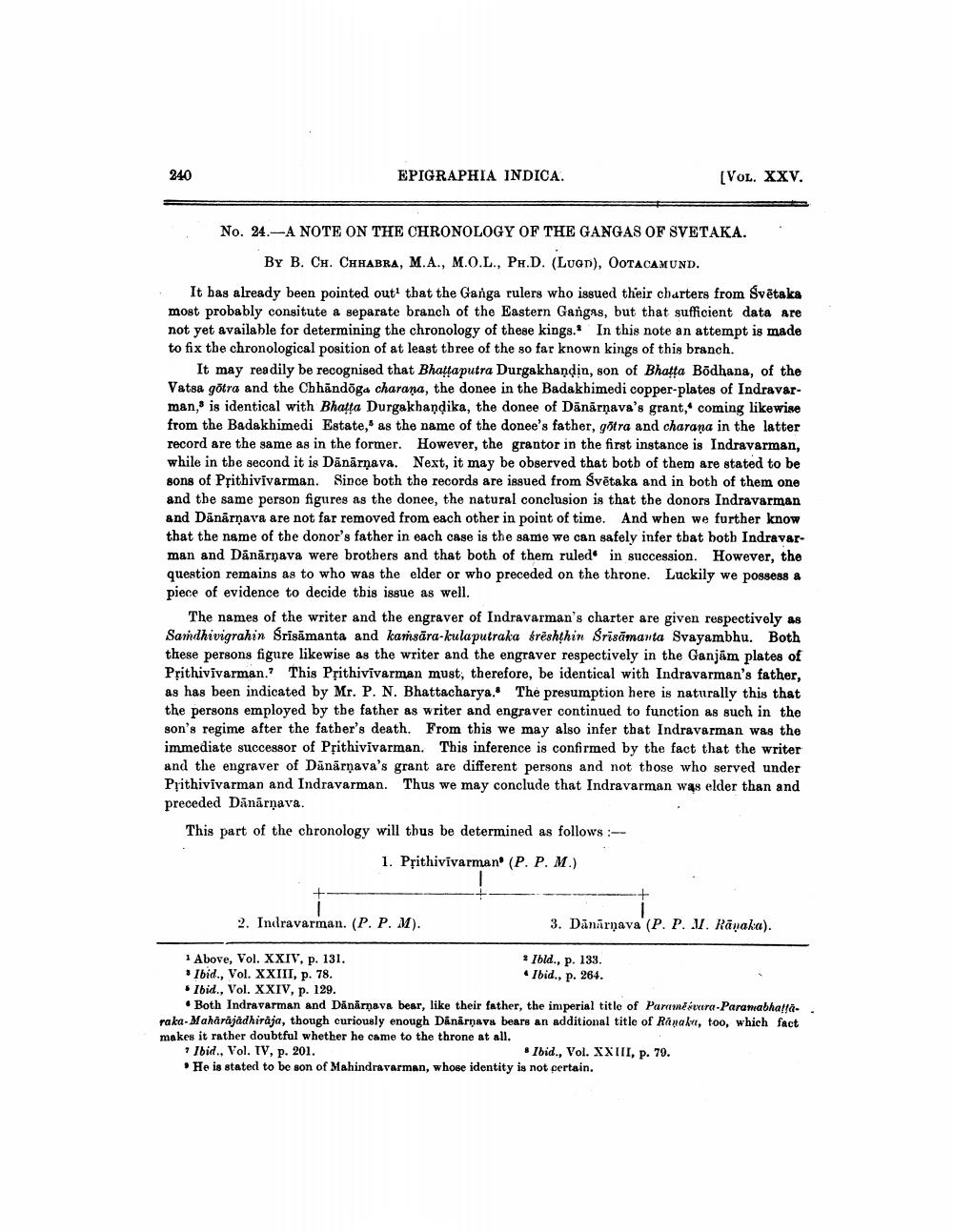________________
240
EPIGRAPHIA INDICA.
No. 24. A NOTE ON THE CHRONOLOGY OF THE GANGAS OF SVETAKA.
BY B. CH. CHHABRA, M.A., M.O.L., PH.D. (LUGD), OOTACAMUND.
It has already been pointed out1 that the Ganga rulers who issued their charters from Svētaka most probably consitute a separate branch of the Eastern Gangas, but that sufficient data are not yet available for determining the chronology of these kings. In this note an attempt is made to fix the chronological position of at least three of the so far known kings of this branch.
It may readily be recognised that Bhattaputra Durgakhandin, son of Bhatta Bōdhana, of the Vatsa gōtra and the Chhandōga charana, the donee in the Badakhimedi copper-plates of Indravarman, is identical with Bhatta Durgakhandika, the donee of Dānārṇava's grant, coming likewise from the Badakhimedi Estate, as the name of the donee's father, götra and charana in the latter record are the same as in the former. However, the grantor in the first instance is Indravarman, while in the second it is Dānārņava. Next, it may be observed that both of them are stated to be sons of Prithivivarman. Since both the records are issued from Svētaka and in both of them one and the same person figures as the donee, the natural conclusion is that the donors Indravarman and Dānārṇava are not far removed from each other in point of time. And when we further know that the name of the donor's father in each case is the same we can safely infer that both Indravarman and Dānārṇava were brothers and that both of them ruled in succession. However, the question remains as to who was the elder or who preceded on the throne. Luckily we possess a piece of evidence to decide this issue as well.
[VOL. XXV.
The names of the writer and the engraver of Indravarman's charter are given respectively as Samdhivigrahin Śrīsāmanta and kaṁsāra-kulaputraka śrëshṭhin Srisamanta Svayambhu. Both these persons figure likewise as the writer and the engraver respectively in the Ganjam plates of Prithivivarman. This Prithivivarman must, therefore, be identical with Indravarman's father, as has been indicated by Mr. P. N. Bhattacharya. The presumption here is naturally this that the persons employed by the father as writer and engraver continued to function as such in the son's regime after the father's death. From this we may also infer that Indravarman was the immediate successor of Prithivivarman. This inference is confirmed by the fact that the writer and the engraver of Danarṇava's grant are different persons and not those who served under Prithivivarman and Indravarman. Thus we may conclude that Indravarman was elder than and preceded Danārṇava.
This part of the chronology will thus be determined as follows:--
1. Prithivivarman (P. P. M.)
+ I
2. Indravarman. (P. P. M).
3. Dänarnava (P. P. M. Rauaka).
1 Above, Vol. XXIV, p. 131. Ibid., Vol. XXIII, p. 78. Ibid., Vol. XXIV, p. 129.
Both Indravarman and Dänärṇava bear, like their father, the imperial title of Paramesvara-Paramabha!!araka-Mahārājādhiraja, though curiously enough Danarnava bears an additional title of Ranaka, too, which fact makes it rather doubtful whether he came to the throne at all.
? Ibid., Vol. IV, p. 201..
2 Ibid., p. 133. Ibid., p. 264.
Ibid., Vol. XXIII, p. 79. He is stated to be son of Mahindravarman, whose identity is not certain.




